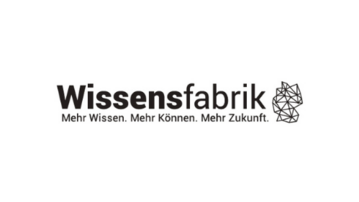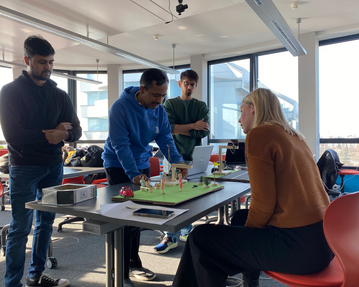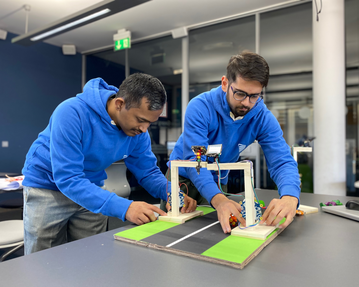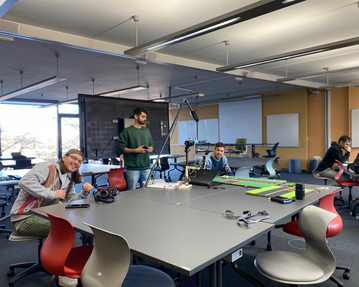This project takes place in collaboration with “Wissensfabrik”. Wissensfabrik develops educational projects in which school children learn about and understand STEM topics in an very action-oriented way.
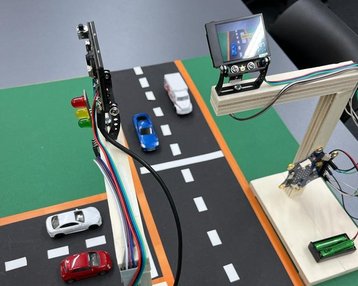
What is the project about?
This project takes place in collaboration with “Wissensfabrik”. Wissensfabrik develops educational projects in which school children learn about and understand STEM topics in an very action-oriented way. The Ferry Porsche Foundation supports the project "KiTec goes AI" and finances the project development. The project is being developed cooperatively by scientific partners and Wissensfabrik - Unternehmen für Deutschland e.V.
The core team of the project development consists of the SRH Heidelberg, who are developing the underlying technologies, subject didacticians, who are responsible for the didactical elaboration, and the Wissensfabrik, who are developing the general concept. Customers for this case study are school children from class 5 till 10 (10 – 16 years old) and school teachers (also from other disciplines, without technical and IT knowledge).
The project KiTec goes AI is to be used in the classroom at schools so that students together with their teacher explore, try out and use artificial intelligence in a miniature road traffic model. It is important that the students actively carry out the entire process of artificial intelligence (machine learning) on their own when using the project KiTec goes AI. In this way, they learn how an AI works, where its risks lie and where errors can occur. This is to be done on the basis of intelligent traffic light circuits on a miniature street model.
The students will use image recognition of cars, bicycles, ambulances and pedestrians to intelligently switch and program traffic lights.The goal of the students in the Kitec goes AI module is to efficiently regulate traffic.The underlying technologies will be elaborated as part of the case study: Which Software should be used in the project? Which hardware? What is the technical design? What is the technical background information? These questions must always be answered against the background of the use in school lessons with pupils.
How did the idea come about?
In the 1950s and 1960s, police officers intelligently managed traffic. The police officers automatically recognized the volume of traffic, were aware of pedestrians and cyclists, and made intelligent decisions to ensure an efficient flow of traffic. Later, automatic but not intelligent traffic lights took over this task. But what if our traffic lights could also react intelligently to the respective situation? Recognize which road users* are participating in traffic and decide what the best response is in each case. A traffic light system equipped with AI. This has already been a reality in Linz since June 2022: a pedestrian traffic light that recognizes road users after a learning phase with the integrated deep learning algorithms and switches the green phase accordingly.
The use of AI in road traffic could ensure an optimal flow of traffic and thus the lowest possible environmental and climate impact - that is the desire of the urban future and that is exactly what this case study is about. Students take up the challenge of what a road traffic management needs to become intelligent. Using traffic lights as an example, students explore how cars, ambulances, cyclists and pedestrians can be safely detected and how efficient traffic light control must be designed. As a part of KiTec goes AI they can can build them with KiTec materials. Toy figures can be used for the participants appearing in road traffic. Intelligent road traffic flow management is to be demonstrated in the KiTec goes AI project using the example of intelligent traffic lights. It must be possible to transfer the principle to other structures and vehicles. Here, KiTec's barge or vehicles can also be used or new structures can be built, such as a street lantern. Or as an alternative to red-yellow-green traffic lights, intelligently switched speed limits. Various road scenarios are also conceivable.
What makes the project special?
The project KiTec goes AI is to be used in the classroom at schools so that students together with their teacher explore, try out and use artificial intelligence in a miniature road traffic model. It is important that the students actively carry out the entire process of artificial intelligence (machine learning) on their own when using the project KiTec goes AI. In this way, they learn how an AI works, where its risks lie and where errors can occur. This is to be done on the basis of intelligent traffic light circuits on a miniature street model. The students will use image recognition of cars, bicycles, ambulances and pedestrians to intelligently switch and program traffic lights.
The goal of the students in the Kitec goes AI module is to efficiently regulate traffic. The underlying technologies will be elaborated as part of the case study: Which Software should be used in the project? Which hardware? What is the technical design? What is the technical background information? These questions must always be answered against the background of the use in school lessons with pupils. The student of SRH have also developed the digital version the miniature road traffic model by following data science pipeline starting from Data Collection till Deployment of as shown below.
What are the next steps?
The next steps for the project could include further development and refinement of the technology, as well as expansion into new markets and industries. In terms of technology development, system could be improved by adding more scenarios and refined to increase its accuracy and effectiveness in identifying the required technical skills for specific job roles. This could involve further training of the machine learning algorithms using larger datasets, as well as incorporating user feedback to improve the relevance and accuracy of the results.
Prof. Dr. Swati Chandna, Prof. Dr. Binh Vu, Prof. Benjamin Zierock, students of the April 2022 batch
